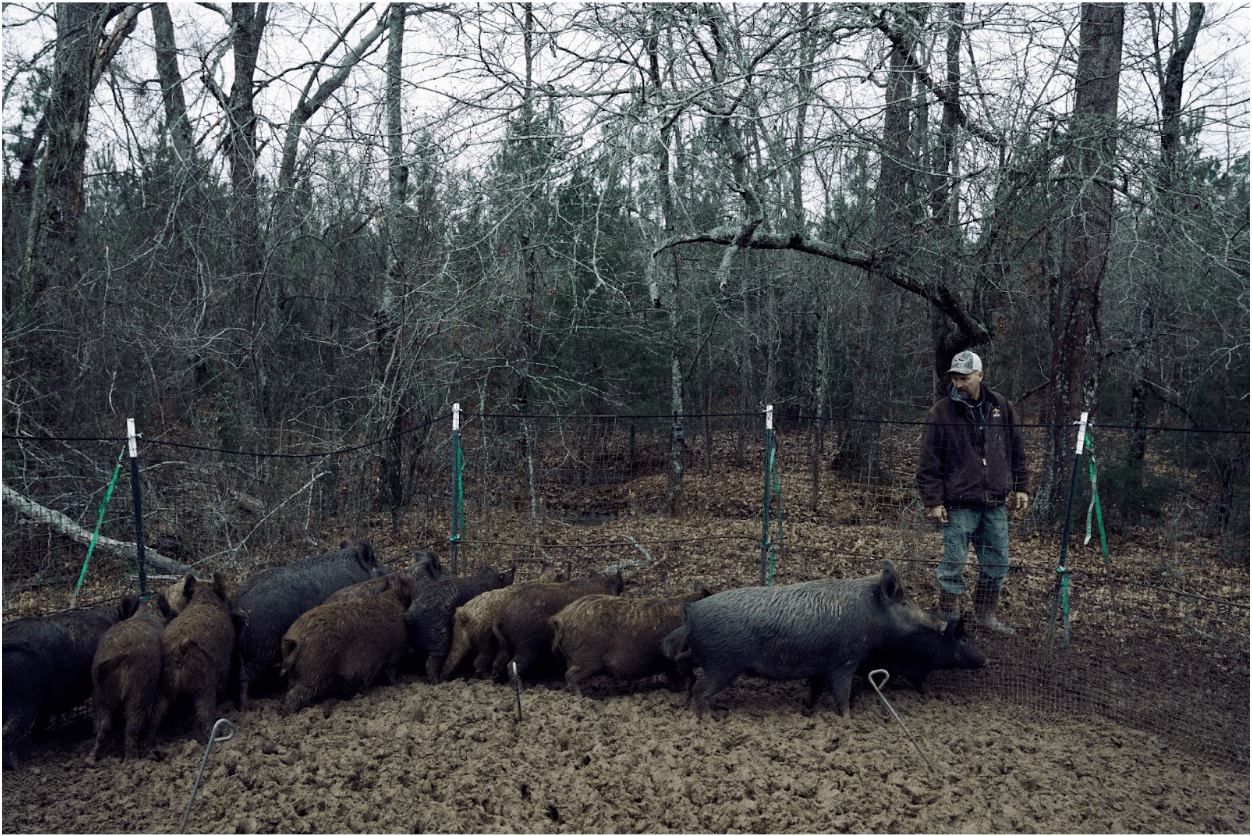For many, the word “pig” calls to mind visions of adorable pink, curly-tailed farm animals or storybook characters like Wilbur or Piglet. However, pigs are also among the most destructive invasive species in the United States.
The rise of wild pigs in areas such as Florida, Georgia, and Texas has created an untenable situation for farmers, homeowners, and city officials alike. The wild pig has no natural predators, is incredibly smart, reproduces rapidly, and can be aggressive — all factors that have led it to cause expensive damage and devastation to everything from farmland to cemeteries.
Studies show that there may be as many as 9 million feral hogs in the United States, making this an epidemic-level problem. There has been a concerted effort to control the feral hog population in the last several decades, with lethal approaches such as aerial shooting being a go-to method of trimming the population. Others use traps set with diesel-soaked corn to lure the pigs, which is bad for the environment and leads to pigs eventually avoiding the traps as the corn makes them sick.
Pig Brig Traps have emerged as a new solution to the overwhelming wild pig problem. This innovation in trap technology elevates trapping with a continuous catch-trap approach.
“Catching just a few wild pigs at a time has limited impact,” says Vickie DeNicola, founder of Pig Brig. “The Pig Brig Trap is the easiest trap to set up and operate — and is effective at whole sounder capture — which can help mitigate local damage.”
A new type of trap
Many wild hog traps have been introduced to the market over the years. Some are very effective in catching a single wild hog here or there, but feral hogs have a very high reproductive rate and travel in family groups called “sounders.” Some experts have likened them to cockroaches in their numbers and level of invasiveness. This makes traps that only catch one or two pigs here or there ultimately ineffective.
“Pigs are smart, and when they see one of their buddies in a single-catch trap, they learn to avoid it,” says DeNicola.
Traps meant to catch a larger number of pigs do exist, though these can be expensive, and many rely on a remotely triggered gate and cameras, which require cell or satellite service. In addition, they can be challenging to set up, often requiring multiple people and more limited site selection.
“Wild pigs don’t travel along any service map,” DeNicola explains. “They forage their way across the landscape typically after dark, which means if you need to trigger a trap door, you have to stay up waiting for them, and if you don’t spring the gate at the exact right moment, you’ve wasted your time.”
With Pig Brig, these pain points in pig trapping have been addressed. The continuous-trap design allows for multiple sounders to be caught at once. In addition, the design does not rely on technology. Instead, Pig Brig takes advantage of the pig’s instinct to root.
“The trap is simple and quiet,” says DeNicola, “The pigs instinctively root under the trap’s mesh walls and follow each other in. Once they do, they often don’t even realize they’re trapped.” Once the entire sounder is trapped, all that is left to do is to return the next morning and eliminate the entire threat — all at once.
Ease of use and field-proven
The Pig Brig is safeguarding farming and human living spaces through its simple and effective design that eschews heavy gates or metal walls. The trap is easy to move and set up and doesn’t require any cell or satellite connection to work.
“The Pig Brig was designed with professional trappers and their need to catch large groups of wild pigs in mind,” says DeNicola. The trap has been field-tested from the outback of Australia to big hogs that cause massive destruction in Texas and Arkansas, creating fans wherever it is set up.
The design includes two layers of 8,000-pound, test-certified netting that can bend but won’t break, even when up against powerful boars. Users can even purchase a trap cap that heads off the cleverest of boars that try to escape by jumping off another boar’s back.
The trap has been so effective in the field that one trap in Louisiana was successful in netting 63 pigs in one shot, making a significant dent in the wild boar population.
The negative impact of wild boars cannot be overstated. One study showed that wild boars in Texas caused over $1.6 million in damages to cemeteries and golf courses in just one year. Not only are they monumentally destructive to land and other wildlife, but many carry diseases that can transfer over to humans. In addition, large sounders have become road hazards in many states. The need for an effective, affordable, and easy trap has never been greater.
“We like to say ‘the boar stops here,’” says DeNicola. If the folks at Pig Brig have anything to say about it, the takeover of the wild boar will soon be a distant memory.

